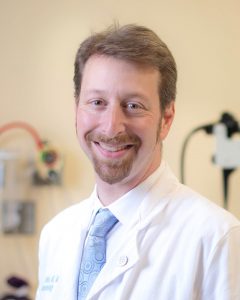The FDA has approved two medications for the treatment of eosinophilic esophagitis (EoE)—the first oral medication tailored for adults and the exclusive therapeutic option for children. Evan Dellon, MD, MPH, internationally known for his work with EoE, and colleagues continue to focus on optimizing usage for effective, personalized outcomes.

Eosinophilic esophagitis (EoE) is an allergic inflammatory disorder that affects the esophagus, causing distressing symptoms such as difficulty swallowing in adolescents and adults, and vomiting and abdominal pain in children.
Evan Dellon, MD, MPH, a gastroenterologist at UNC Health and professor of medicine in the Division of Gastroenterology and Hepatology at the UNC School of Medicine, has been at the forefront of groundbreaking developments in EoE treatment.
His efforts, published in the journal Clinical Gastroenterology and Hepatology helped lead to the recent FDA approval of budesonide, the sole oral therapy designed for individuals aged 11 and older with EoE—a significant milestone. Dellon and colleagues have been diligently working towards for more than 10 years. Prior to this approval patients had to make “home brews” of budesonide slurries by adapting asthma medications that were originally formulated for nebulizer machines.
Takeda Pharmaceuticals announced the twice-daily treatment will be available in single-dose stick packs (2mg/10mL) by the end of February. Dellon, part of the research team, demonstrated budesonide’s efficacy in achieving histologic remission and improving swallowing ability in patients.
Key findings from the two multicenter, randomized, double-blind, parallel-group, placebo-controlled 12-week studies include:
- 53.1% (Study 1) and 38% (Study 2) of patients receiving budesonide achieved histologic remission compared to 1% (Study 1) and 2.4% (Study 2) in the placebo group.
- Patients taking budesonide reported less difficulty swallowing.
- Budesonide has not been shown to be safe and effective for the treatment of EoE for longer than 12 weeks.
Pediatric Patients with EoE

Additionally, the FDA recently approved dupilumab for pediatric patients aged one to eleven, marking a significant advancement in addressing this condition.
Previously, there was a void in approved medications for pediatric EoE patients. Dellon was one of the lead investigators, along with Sabina Mir, MD, a pediatric gastroenterologist at the UNC Children’s Research Institute, who headed UNC as a clinical trial site for the study that influenced this approval.
“This is the first medication to be approved for this younger population of children with EoE, addressing a critical need for therapy in this group and providing a treatment that can improve multiple EoE disease features and hopefully prevent complications like future esophageal stricturing,” said Dellon.
Dupilumab for Adolescents and Adults
It’s been almost two years since dupilumab was first approved to treat individuals 12 and older with EoE, another milestone that to which Dellon’s research contributed. He says the real-world use of dupilumab mirrors the promising outcomes observed during the clinical trials.
“It’s been very impactful, I have probably more than 100 people on it now,” said Dellon. “I had a large cohort of patients who just didn’t respond to other treatments and were waiting for something like this to become available.”
Historically, physicians relied on food elimination diets, off-label treatments, such as stomach acid reducers (proton pump inhibitors) or asthma steroid medications (which are swallowed to coat the esophagus rather than inhaled) and stretching the esophagus with dilation during endoscopy.
“Many of them had esophageal strictures so the esophagus was mechanically stretched to help them decrease their symptoms of trouble swallowing,” explained Dellon. “After three or six months, they would come back and the esophagus would just shrink back again, because all the inflammation was still going on.”
A study published in the journal Clinical Gastroenterology and Hepatology by Christopher Lee, MD, a UNC internal medicine resident, and Dellon analyzed 46 patients with severe EoE who had undergone multiple esophageal dilations. They found that many patients experienced remission and sustained improvements in esophageal diameter upon dupilumab treatment.
Although these findings are promising, more research is needed to determine longer-term treatment outcomes for severe EoE and whether dupilumab could be used earlier, for example right after diagnosis, for these most affected patients.
The Road Ahead
As the spotlight remains on EoE treatment, the focus now shifts to understanding dupilumab’s optimal utilization, considering factors such as disease progression, response variations, and dosing frequence long-term. Clinical trial participants had EoE an average duration of five years since diagnosis, coupled with unresponsiveness to proton pump inhibitors, when they entered the study.
However, uncertainty lingers regarding whether newly diagnosed patients will exhibit similar responses or fare better than those in the trials. Additionally, the efficacy of dupilumab in more severe cases of EoE needs to be studied in more depth, and several studies related to this are opening soon at UNC and other sites. Dupilumab’s recommended dosage for EoE treatment is a weekly regimen, a departure from its alternative bi-weekly uses in treating asthma and eczema.
“That was primarily because we only saw symptom benefit with weekly dosing in the approval study,” said Dellon. “However, the question is, as people feel well, can you decrease the intensity of the therapy long term? It’s a very expensive medicine, so understanding how to best use those resources is pretty critical.”
Interestingly, a series of trials explored the impact of medications that removed eosinophils (white blood cells that inflame the esophagus) from the body on EoE. The assumption was patients would get better.
“What we saw in these studies were that the eosinophils went away on the biopsies, so the medication was working biologically, but there were still other persistent changes when you look under the microscope that didn’t get better,” explained Dellon. “And when you look at the esophagus, it wasn’t improved visually either and patient’s symptoms didn’t improve. This raises this question of, well, what else is driving the disease if it’s not the eosinophil?”
The ultimate goal is to tailor treatment strategies based on the specific pathogenic mechanisms driving each patient’s condition. Dellon aims for a future where a comprehensive understanding of EoE profiles guides the selection of biologics, dietary interventions, and steroid therapies with precision. This personalized approach holds the promise of more effective and sustainable outcomes for individuals grappling with the challenges of eosinophilic esophagitis.
Media contact: Morgan Duerden, Communications Specialist, UNC Department of Medicine